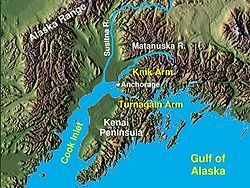The State of Alaska is both a producer and consumer of natural gas. In 2006, Alaska consumed 180.4 Bcf of natural gas.[1]
| Share of total US gas consumption (percentage) | ||||||
|---|---|---|---|---|---|---|
| Use | 2001 | 2002 | 2003 | 2004 | 2004 | 2006[2] |
| Residential | 0.35 | 0.33 | 0.33 | 0.37 | 0.37 | 0.47 |
| Commercial | 0.52 | 0.50 | 0.54 | 0.59 | 0.56 | 0.65 |
| Industrial | 0.92 | 0.88 | 0.58 | 0.65 | 0.80 | 0.58 |
| Vehicle Fuel | 0.09 | 0.08 | 0.09 | 0.09 | 0.17 | 0.17 |
| Electric Power | 0.61 | 0.56 | 0.67 | 0.69 | 0.67 | 0.70 |
Alaskan gas wells are located in two regions. The largest source is the North Slope area around Prudhoe Bay where gas was discovered along with oil in 1968. In 1974 the State of Alaska's Division of Geological & Geophysical Surveys estimated that the field held 26×1012 cu ft (740 km3) of natural gas.[3] Because there is no way to transport the Prudhoe Bay gas to markets, as gas comes out of the wells, it is separated from the oil stream and reinjected into the ground to maintain the oil reservoir pressures. There are several proposals to transport the Prudhoe Bay gas. See, Alaska Gas Pipeline.

The second source is located on the Kenai Peninsula on the South coast of Alaska. There are probable gas reserves of 1,726.4 Bcf in this area.[4] Most of this gas is exported to Japan through a liquefied natural gas terminal located on the Cook Inlet. The Cook Inlet basin contains large oil and gas deposits including several offshore fields.[5] As of 2005 there were 16 platforms in Cook Inlet, the oldest of which is the XTO A platform first installed by Shell in 1964, and newest of which is the Kitchen Lights Unit platform installed by Crowley and supported by the German engineering and project management companies Heavylift@Sea, Overdick and Projektbox installed in 2015. Most of the platforms are operated by Union Oil which was acquired by Chevron in 2005. There are also numerous oil and gas pipelines running around and under the Cook Inlet. The main destinations of the gas pipelines are to Kenai where the gas is primarily used to fuel commercial fertilizer production and a liquified natural gas (LNG) plant and to Anchorage where the gas is consumed largely for domestic uses.[6] ConocoPhillips and Marathon operate the LNG terminal under a series of two-year-long licenses issued by the U.S. Department of Energy under Section 3 of the Natural Gas Act.[7] When these companies applied for another two-year extension of the license, various Alaskan entities, including the local fertilizer plant opposed the application on the grounds that there was not sufficient gas to meet local requirements as well as the proposed exports. The Agrium fertilizer plant claimed it closed because it could not obtain a gas supply. On June 3, 2008, the Department of Energy granted the extension having found that there were sufficient supplies for Alaska's needs.[4] On 22 July 2014, the Alaska LNG project submitted an application to export LNG to the US Department of Energy (DOE). ExxonMobil has confirmed that the Alaska LNG project will seek to export up to 20 million tpa of LNG. The project will export LNG for a period of 30 years to countries that have existing free trade agreements (FTA) with the US, as well as to non-FTA countries. The project is anticipated to create up to 15,000 jobs during construction and approximately 1000 jobs for operation of the project. ExxonMobil has confirmed that the Alaska LNG project will seek to export up to 20 million tpa of LNG. The Alaska LNG project participants are the Alaska Gasline Development Corp. (AGDC) and affiliates of TransCanada, BP, ConocoPhillips, and ExxonMobil. The LNG project is now in the pre-front-end engineering and design phase, which is expected to be completed in 2016.[8]
- ^ DOE Opinion and Order No. 2500 (PDF), p. 49. U.S. Department of Energy (June 3, 2008). Retrieved 2008-09-15.
- ^ Alaska Share of Total U.S. Natural Gas Delivered to Consumers Archived 2009-03-14 at the Wayback Machine. Energy Information Administration. Retrieved 2008-09-16.
- ^ Estimated Speculative Recoverable Resources of Oil and Natural Gas in Alaska. Division of Geological & Geophysical Surveys. Department of Natural Resources. State of Alaska. January 1974. (Adobe Acrobat *.PDF document)
- ^ a b DOE Opinion and Order No. 2500 (PDF), p. 45. U.S. Department of Energy (June 3, 2008). Retrieved 2008-09-15.
- ^ "Cook Inlet Oil and Gas". Retrieved 2007-02-03.
- ^ "Kenai, Alaska plant". agrium.com. Archived from the original on 2006-10-14. Retrieved 2007-02-03.
- ^ 15 U.S.C. § 717b
- ^ "Alaska LNG files export application". July 22, 2014.